Indonesia Payments Infrastructure Market Size
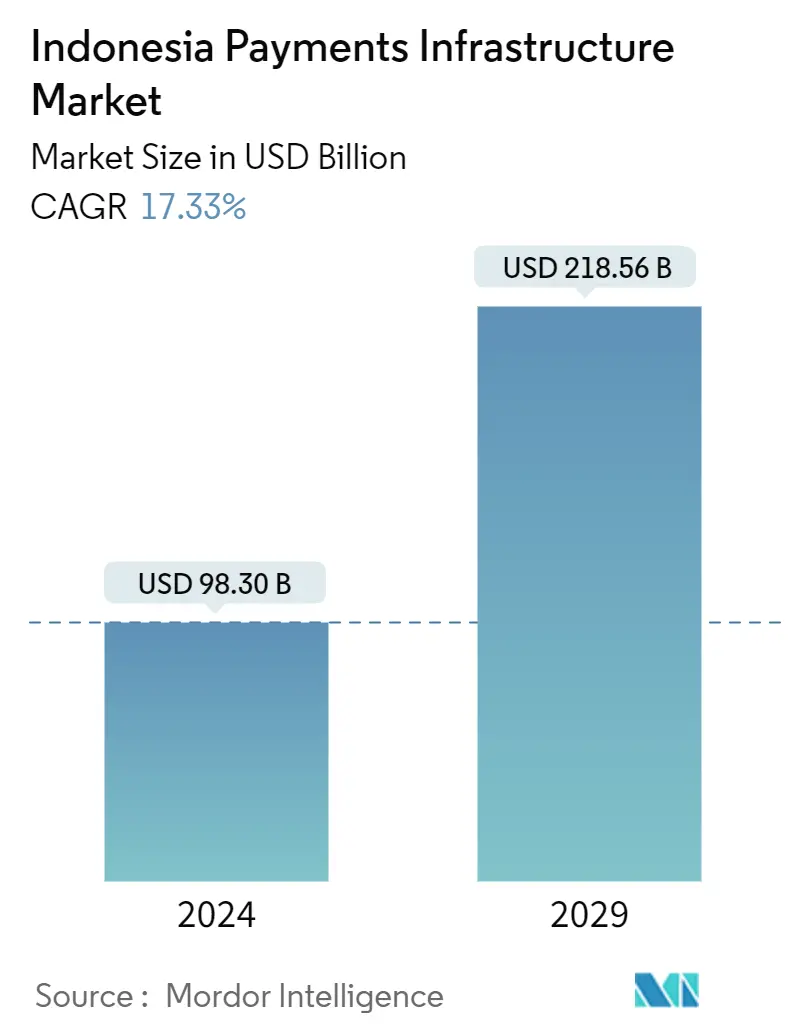
| Study Period | 2019 - 2029 |
| Base Year For Estimation | 2023 |
| Market Size (2024) | USD 98.30 Billion |
| Market Size (2029) | USD 218.56 Billion |
| CAGR (2024 - 2029) | 17.33 % |
| Market Concentration | Medium |
Major Players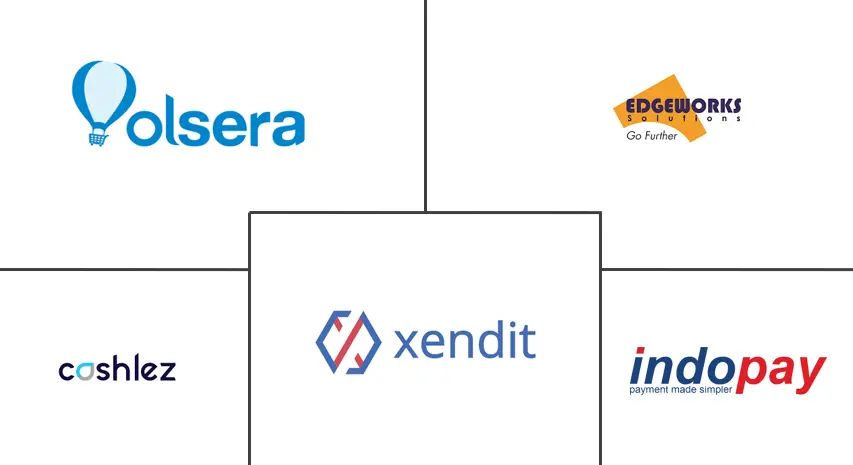
*Disclaimer: Major Players sorted in no particular order |
Indonesia Payments Infrastructure Market Analysis
The Indonesia Payments Infrastructure Market size is estimated at USD 98.30 billion in 2024, and is expected to reach USD 218.56 billion by 2029, growing at a CAGR of 17.33% during the forecast period (2024-2029).
The COVID-19 pandemic drastically changed the way consumers shop, affecting several verticals of the market. The retail sector witnessed a drastic change due to the pandemic. Consumers increased their use of various sales methods, such as curbside pickup, virtual consultations, contactless payment, and social commerce, i.e., shopping through social media. According to retail experts and shopper surveys, this new behavior is expected to stay during the forecast period. Hence, the demand for digital payment infrastructure improvisation is expected to increase due to the change in shopping behavior caused by the pandemic.
- The country has witnessed waves of digitalization and its diffusion across industries over the past decade. With the presence of connected devices becoming inevitable, the economic and financial landscape has changed significantly. Also, with current digitalization across industries, consumers are increasingly demanding fast, affordable, and safe financial services. Such trends have substantially increased the need for the evolution of payment methods across the world.
- Furthermore, due to the pandemic, Indonesia has seen a surge in digital adoption among consumers and an accelerated growth of both digital payments and e-commerce platforms. According to the Bank Indonesia (BI), the value of electronic money transactions reached IDR 201 trillion (USD 13.95 billion) in 2020, growing by 38.62% from IDR 145 trillion (USD 10.07 billion) in 2019. The adoption of digital and cashless payment methods has, in turn, spurred the growth of the adoption of POS terminals at various payment gateways.
- With the growing digital payment infrastructure in the country, the economic and financial authorities are facing policy challenges in the digital era. Bank Indonesia, in particular, strikes an appropriate balance between efforts to optimize the opportunities afforded through digital innovation with efforts to mitigate the inherent risks.
- For this, the Indonesia Payment System Vision and Indonesia Payment System Blueprint for 2025 provided an unambiguous direction in terms of exploiting digitalization while implementing Bank Indonesia's mandate in terms of currency in circulation, monetary policy, and financial system stability. The Blueprint comprises five visions of the Indonesian Payment Systems 2025, further translated into five major initiatives and manifested into 23 key deliverables implemented in stages from 2019 to 2025.
- With the Indonesia Payment Systems Blueprint 2025, the country aims to make digital innovation accessible for 91.3 million unbanked people and 62.9 million MSMEs in Indonesia to formal economics and finance in a sustainable manner. Thus, all efforts are directed toward a stronger and more evenly distributed Indonesia in the future.
Indonesia Payments Infrastructure Market Trends
Electronic Data Capture (EDC)
- Electronic data capture (EDC) machines/POS terminals are used for accepting payments at all retail outlets. They are basically devices used for cashless transactions.
- POS terminal systems evolved from being transaction-oriented terminals/devices to systems that can integrate with the company's CRM and other financial solutions. This evolution, thus, empowered the end-users with business intelligence to better manage their revenue streams and inventory. With the functional benefits that the advanced POS systems offer, companies have replaced their traditional billing software with POS systems, thus, securing the growth of the market.
- Additionally, mobile POS (mPOS) terminals have quickly evolved as an essential tool enabling merchants of all sizes to accept card payments. They are being used increasingly for payments, inventory management, printing bills, and offering loyalty programs across various industry verticals.
- Such trends are expected to spur strategic collaborations and innovations by the solution providers in the country. With the recent acquisition of MOKA by Gojek, connectivity between online delivery service and POS terminal appears to be on the horizon. Prior to that, Pawoon has made the first move for integration by connecting transactions from GrabFood into its system.
- Furthermore, new device innovation by the players aiming for SME businesses is expected to address significant market growth. In December 2020, Gojek, a Southeast Asian super-app operator, announced its new point-of-sale (POS) device, GoBiz Plus, for all-in-one purposes for micro and small- to medium-sized businesses (SMBs) in Indonesia.
- The device is a collaboration with PT Bank Central Asia and serves as an extension to the merchant super app GoBiz. GoBiz Plus works to help merchants accept cashless payment methods for offline transactions and embrace new digital strategies. The company stated that its services had aided over 900,000 retailers in accessing digital operations.
- Furthermore, players are investing in the digital solution, which integrates with POS solutions. In November 2020, Smart POS Terminal Z90 contributed to fintech LinkAja to promote mobile payment. Furthermore, the Southeast Asian ride-hailing and food delivery giant Grab led a Series B investment round in the Indonesian digital payments firm, LinkAja. Such steps are expected to augment significant market growth in the country.
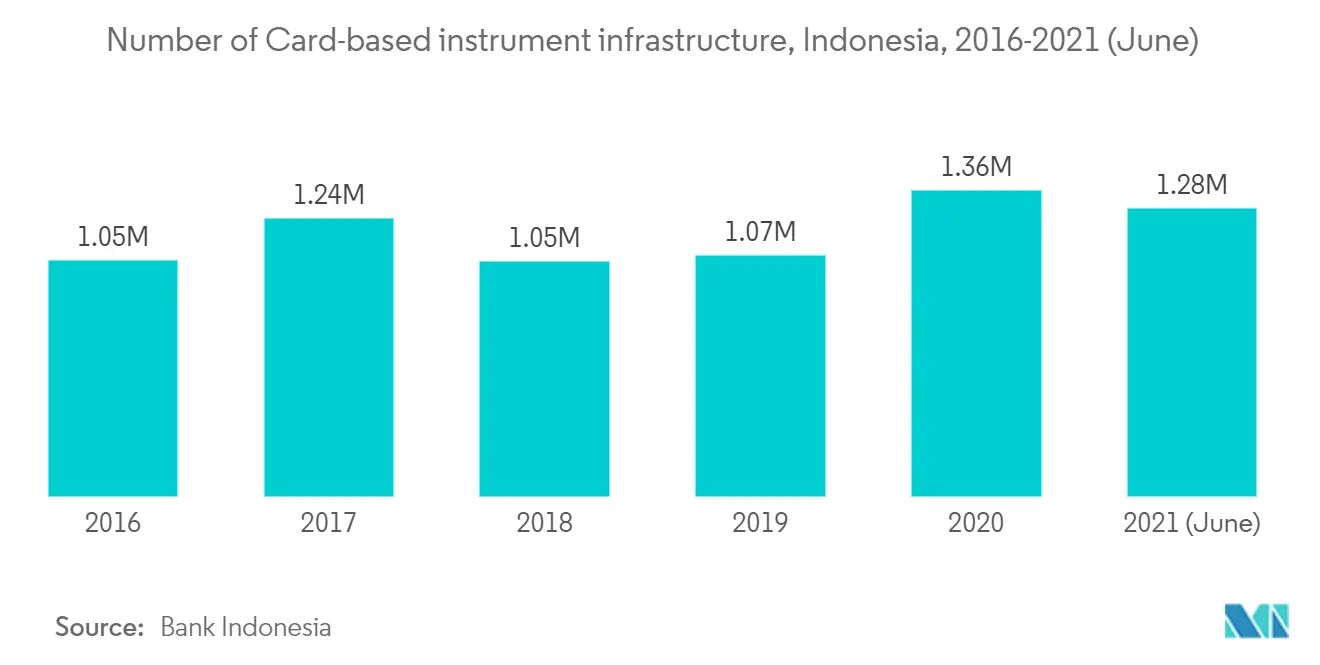
Consumer Payment Landscape
- The user base for digital payment methods in the country is on the rise, and consumers are increasingly using the technology on a regular basis. The growing number of e-commerce transactions and e-commerce users in the country is expected to act as a major factor in changing the consumer payment landscape.
- According to a study presented by Statista, the number of e-commerce users in Indonesia is expected to grow to 221 million in 2025, representing a significant increase since 2017, where e-commerce users stood at approximately 70.1 million users.
- Paypal, Apple Pay, Visa Checkout, and Google Pay are some of the major enterprises that command a prominent share of active users. Apart from this, the user acceptance of digital payments is increasing at an exponential rate where more and more users are ready to use these modes of payment.
- According to a survey conducted by WorldPay, in February 2020, about 84% of e-payment users stated that they used e-payment transactions to pay online purchases. Its convenience and practicality were the leading reasons why Indonesians chose e-payment transactions.
- Furthermore, OVO ranked first among the most-used digital payment platforms in Indonesia as of 2020, followed by Gopay and DANA. The security of the platform and its enriching customer services were the top reasons why consumers preferred these payment platforms.
- While GoPay is associated with Gojek and used exclusively for transactions within the app, OVO partnered with Gojek's biggest rival, Grab, and one of the largest e-commerce platforms in Indonesia, Tokopedia, to help secure its position as the country's most-used mobile payment service/app. Similar initiatives and collaborations by the payment platform providers are expected to further spur the growth in the adoption of digital payment methods by consumers.
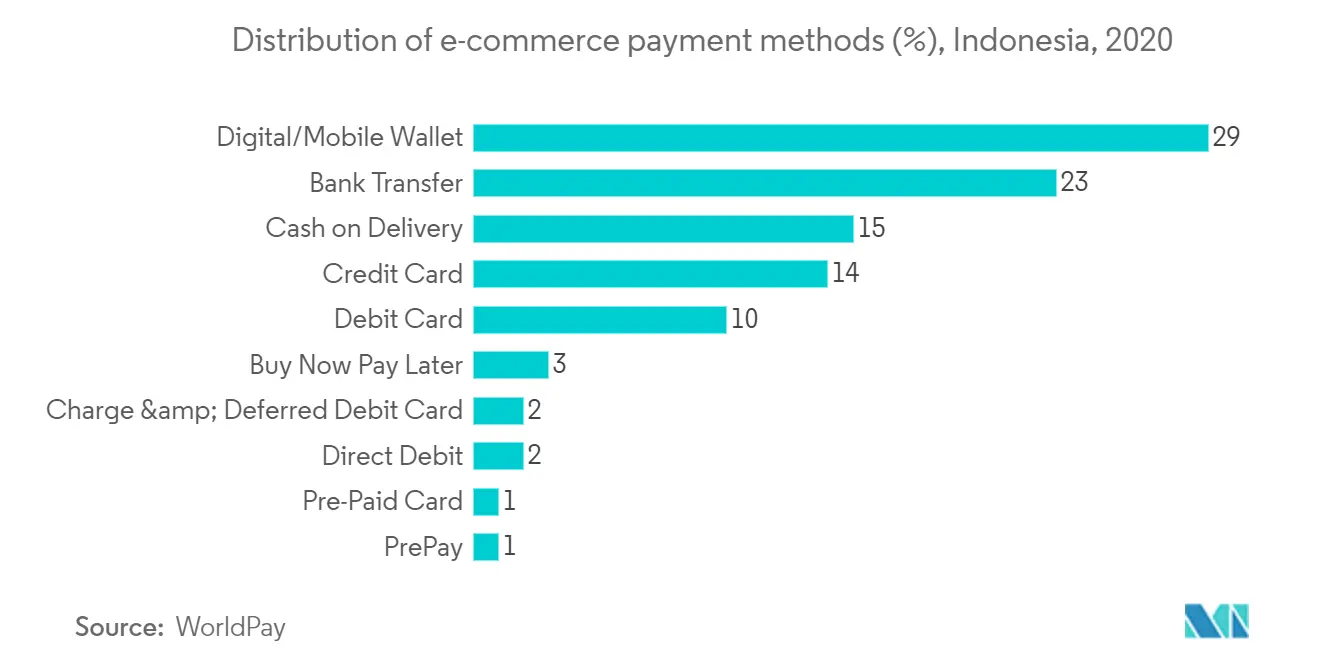
Indonesia Payments Infrastructure Industry Overview
The Indonesia Payments Infrastructure Market is moderately concentrated. The competitive rivalry in the market studied is moderate, as a good number of players prevail. Despite several companies in the market studied, firms are required to keep innovating their products to gain a sustainable competitive edge over their rivals and provide product differentiation.
- March 2021- Southeast Asian digital payments infrastructure provider Xendit raised USD 64.6 million in funding. Businesses from small kiosks (warungs) to SMBs and large players, like Transferwise and Grab, use Indonesian-based Xendit's API-based technology to process payments, run marketplaces, disburse payroll, and detect fraud.
- October 2021- PT Jalin Payment Nusantara and PT Bank Pembangunan Daerah Jawa Timur Tbk signed a Cooperation Agreement (PKS) to broaden the scope of banking switching services for the Regional Development Bank segment. Bankjatim is the first book three bank BPD to join Jalin, with total assets of IDR 95.48 trillion.
Indonesia Payments Infrastructure Market Leaders
-
Xendit
-
Olsera.com
-
Edgeworks Solutions Pte Ltd
-
PT Cashlez Worldwide Indonesia
-
PT. indopay merchant services
*Disclaimer: Major Players sorted in no particular order
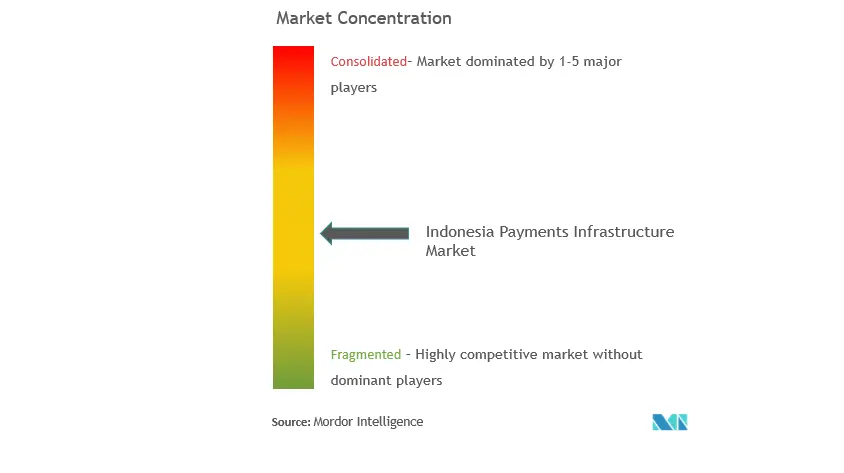
Indonesia Payments Infrastructure Market News
- March 2021- PAX Technology introduced the IM10, the latest unattended payment device that will drive the usage of QR codes and contactless payments in any touchless environment. The IM10 is the newest addition to the IM Series, an all-in-one payment device with a small footprint.
- May 2021- Gojek and Tokopedia announced their merger to become the GoTo Group, with plans to proceed with an IPO and a dual listing in New York and Jakarta by the end of 2021.
Indonesia Payments Infrastructure Market Report - Table of Contents
1. INTRODUCTION
- 1.1 Study Assumptions and Market Definition
2. RESEARCH METHODOLOGY
3. MARKET INSIGHTS
- 3.1 Market Overview
- 3.2 Enabling and Limiting Factors of the Indonesia Payment Industry
- 3.3 Consumer Payment Landscape
4. TRADITIONAL PAYMENTS INFRASTRUCTURE ANALYSIS
-
4.1 Card-based Instrument Infrastructure (2016-2021)
- 4.1.1 ATM
- 4.1.2 Electronic Data Capture (EDC)
- 4.1.3 Merchant
-
4.2 E-money
- 4.2.1 Transactions (Volume and Value, 2016-2021)
- 4.2.2 Instrument Infrastructure (2016-2021)
5. ELECTRONIC PAYMENTS REGULATIONS
6. COMPETITIVE LANDSCAPE
-
6.1 Company Profiles
- 6.1.1 GHL Indonesia (GHL Systems Bhd)
- 6.1.2 PT Cashlez Worldwide Indonesia
- 6.1.3 Moka POS (Go-Jek)
- 6.1.4 Equip POS (HashMicro Pte Ltd)
- 6.1.5 Xendit
- 6.1.6 Pawoon Indonesia
- 6.1.7 Olsera.com
- 6.1.8 Edgeworks Solutions Pte Ltd
- 6.1.9 Centerm
- 6.1.10 Ingenico
- 6.1.11 Pax Technology
- 6.1.12 PT. indopay merchant services
- 6.1.13 Inti Prima Mandiri Utama (iPaymu)
- 6.1.14 PT Jalin Pembayaran Nusantara
- *List Not Exhaustive
7. FUTURE OF THE MARKET
** Subject To AvailablityIndonesia Payments Infrastructure Industry Segmentation
The Scope of the report includes:
Indonesia Payments Infrastructure Market Research FAQs
How big is the Indonesia Payments Infrastructure Market?
The Indonesia Payments Infrastructure Market size is expected to reach USD 98.30 billion in 2024 and grow at a CAGR of 17.33% to reach USD 218.56 billion by 2029.
What is the current Indonesia Payments Infrastructure Market size?
In 2024, the Indonesia Payments Infrastructure Market size is expected to reach USD 98.30 billion.
Who are the key players in Indonesia Payments Infrastructure Market?
Xendit, Olsera.com, Edgeworks Solutions Pte Ltd, PT Cashlez Worldwide Indonesia and PT. indopay merchant services are the major companies operating in the Indonesia Payments Infrastructure Market.
What years does this Indonesia Payments Infrastructure Market cover, and what was the market size in 2023?
In 2023, the Indonesia Payments Infrastructure Market size was estimated at USD 81.26 billion. The report covers the Indonesia Payments Infrastructure Market historical market size for years: 2019, 2020, 2021, 2022 and 2023. The report also forecasts the Indonesia Payments Infrastructure Market size for years: 2024, 2025, 2026, 2027, 2028 and 2029.
Indonesia Payments Infrastructure Industry Report
Statistics for the 2024 Indonesia Payments Infrastructure market share, size and revenue growth rate, created by Mordor Intelligence™ Industry Reports. Indonesia Payments Infrastructure analysis includes a market forecast outlook to 2029 and historical overview. Get a sample of this industry analysis as a free report PDF download.



